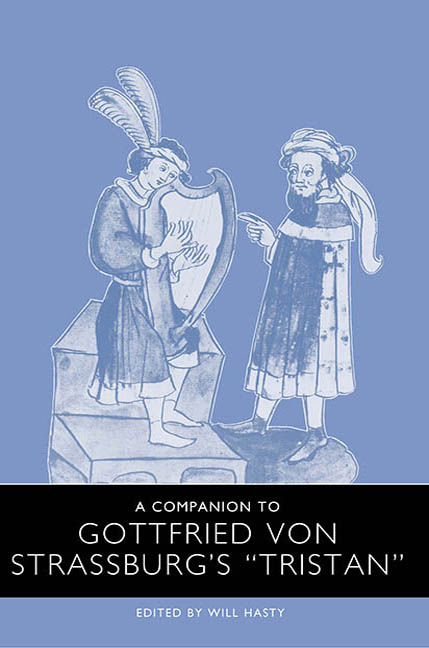Book contents
- Frontmatter
- Contents
- Acknowledgments
- Introduction: The Challenge of Gottfried's Tristan
- I Cultural and Social Contexts
- II Figures, Themes, Episodes
- Gottfried's Adaptation of the Story of Riwalin and Blanscheflur
- This Drink Will Be the Death of You: Interpreting the Love Potion in Gottfried's Tristan
- God, Religion, and Ambiguity in Tristan
- The Female Figures in Gottfried's Tristan and Isolde
- Performances of Love: Tristan and Isolde at Court
- Duplicity and Duplexity: The Isolde of the White Hands Sequence
- III Gottfried's Narrative Art
- IV The Medieval and Modern Reception of Gottfried's Tristan
- Notes on the Contributors
- Index
The Female Figures in Gottfried's Tristan and Isolde
from II - Figures, Themes, Episodes
Published online by Cambridge University Press: 28 April 2017
- Frontmatter
- Contents
- Acknowledgments
- Introduction: The Challenge of Gottfried's Tristan
- I Cultural and Social Contexts
- II Figures, Themes, Episodes
- Gottfried's Adaptation of the Story of Riwalin and Blanscheflur
- This Drink Will Be the Death of You: Interpreting the Love Potion in Gottfried's Tristan
- God, Religion, and Ambiguity in Tristan
- The Female Figures in Gottfried's Tristan and Isolde
- Performances of Love: Tristan and Isolde at Court
- Duplicity and Duplexity: The Isolde of the White Hands Sequence
- III Gottfried's Narrative Art
- IV The Medieval and Modern Reception of Gottfried's Tristan
- Notes on the Contributors
- Index
Summary
Gottfried'sTristan and Isoldecreates one of the most complex and interesting constellations of female figures in all of medieval German literature. The agency and intelligent resolve shown by all the female figures — Blanscheflur, Tristan's mother; Princess Isolde and her mother, Queen Isolde; Brangaene, Princess Isolde's cousin and companion — stand in contrast to the dominant medieval clerical ideology of feminine passivity and weakness. Gottfried's Tristan invites the reader to reflect on the similarities and differences between the lives of these female figures by creating between them a dense network of linkages and allusions based on kinship, imagery, allegory, and shared names. The story enacts what it means to be a woman through the enfolding of plot, character, and imagery, and through philosophical reflection, most notably in two episodes, Queen Isolde's debate with the Irish seneschal (9820–982), and the narrator's excursus on the practice of keeping noblewomen under surveillance to guarantee their chastity (17817– 18114). Gottfried's elaborate and sympathetic treatment of the mother-daughter relationship is unique both in medieval German literature and among the pan-European Tristan stories. The relationship between Isolde and her companion, Brangaene, explores the complexities of women's friendship. Finally, the figure of Isolde is presented in a sequence of contrasting images that pose fascinating and difficult questions about the work's overarching philosophy of love: Is Isolde the personification of love or love's victim, the temptress Eve or a “new” type of woman ennobled by her love and her suffering? In short, Gottfried's Tristan challenges its readers to think about gender, that is to say, about what it means to be a man or a woman in the universe of this work.
Asking about gender means examining the values, assumptions, and practices regarding masculinity and femininity in specific cultures at specific times. It means asking about, for example, beliefs about men's and women's cognitive abilities, about their sexual and emotional characteristics, about the nature and effect of reproductive roles upon the understanding and practice of what it means to be male or female, and about the unequal distribution of economic, social, and political resources in favor of men that marks patriarchal societies. It also means examining cultural beliefs about the physical world of the body and the meanings the body acquires.
- Type
- Chapter
- Information
- A Companion to Gottfried von Strassburg's Tristan , pp. 137 - 158Publisher: Boydell & BrewerPrint publication year: 2003

